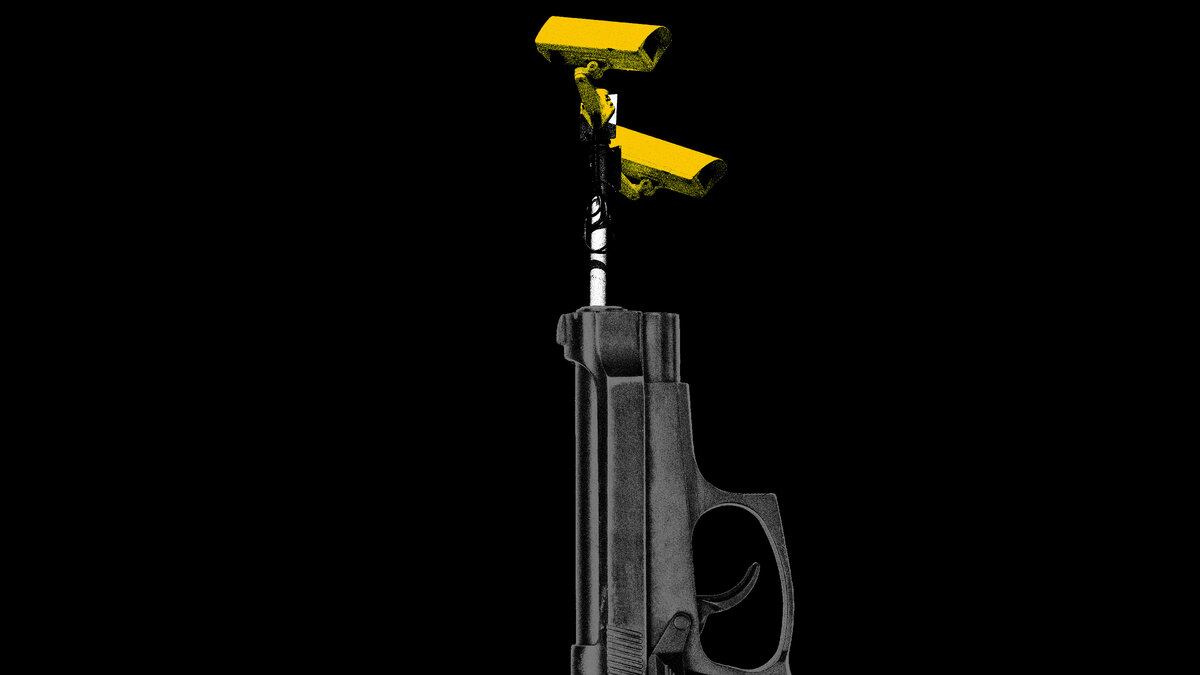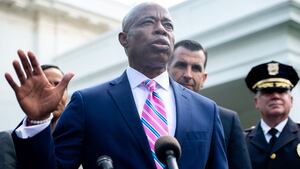After a string of horrific shootings, New Yorkers are legitimately frightened. What crime will stop us in our tracks and be splashed across the tabloid pages?
That fear, felt increasingly across the country, is all too real. Sadly, many of the surveillance systems being sold as the solution are, in fact, a fantasy. But it’s not merely wishful thinking to hope that Silicon Valley will be our salvation; it’s dangerous.
The highest-profile example comes from New York City Mayor Eric Adams, whose new “Blueprint” for public safety lays out everything from expanded use of plainclothes officers to new forms of artificial intelligence. Many of the policing tactics that Adams now advances are familiar to New Yorkers; many are strategies that Adams himself has opposed—as a former cop turned police reform activist.
But while technologies like facial recognition and “gun detection AI” may be new, they raise the same risks of abuse as the analog crime prevention tools he once protested. Not only does Adams’ plan risk rolling back recent civil rights wins—such as restrictions on pre-trial detention and solitary confinement—with today’s visit from President Joe Biden, Adams’ bungling blueprint for New York could become a ruinous roadmap for the country.
Biden’s NYC visit comes as his administration struggles to address the rise in shootings over the past two years, which was fueled in great part by the societal disruptions caused by the COVID-19 pandemic. Predictably, as millions of Americans faced unprecedented economic, health, and safety strains, the upheaval and insecurity tragically translated into violence. Take a traumatized country, add a record increase in gun sales, and you’ve created a powder keg.
Even worse, Biden’s anti-gun efforts are continually stymied by GOP opposition, not just in Congress, but increasingly in the courts. As I write, the Supreme Court justices continue to deliberate the future of New York City’s gun law, and are poised to strike down our license requirements, as well as others across the country.
Under this strain, the danger is that a Biden administration, desperate for anything that can show progress on public safety—and fearful of GOP attacks during the midterm elections—will adopt Adams’ misguided surveillance proposals on the national stage.
Biden has already developed a troubling surveillance record in his time in office. In recent weeks, the IRS faced national outrage for forcing Americans to use facial recognition to access their tax records. Growing numbers of federal agencies are using facial recognition under Biden’s presidency, including groups ranging from the U.S. Fish and Wildlife Service to the National Parks.
If Adams were to follow Biden’s lead, he’d undermine efforts from progressive groups across the country to ban invasive tools like facial recognition.
Portions of Adams’ blueprint feel like stepping out of a dystopian time machine.
In 1999, then-Mayor Rudy Giuliani saw growing opposition to stop-and-frisk from New Yorkers, including then-NYPD Lt. Eric Adams, who rightfully lambasted Giuliani for subjecting hundreds of thousands of young Black and brown New Yorkers to violent harassment from the NYPD, saying, “New Yorkers don't want them [the NYPD] turned loose again.”
Flash forward 23 years, and now-Mayor Adams wants to do just that, reinstating plainclothes units that were disbanded for conducting aggressive, unlawful, and often deadly stops of Black New Yorkers. But where expanded stop-and-frisk will impact thousands of New Yorkers, Adams’ expanded surveillance will impact millions.
Adams boasted that facial recognition could “take a picture of your face and in eight seconds, see everything that you have in public view…” But he never addressed the technology’s bias against Black or brown New Yorkers. Facial recognition has not only been shown to be more error-prone for Black and Latinx individuals in the lab, it’s led to growing numbers of false arrests in the real world. The way that the technology replicates the same patterns of abuse as stop-and-frisk.
Even worse is Adams’ call for “new technology to identify suspects and those carrying guns” using “software to identify dangerous individuals and those carrying weapons.”
Once again we’re being told that Silicon Valley has a crystal ball to predict pre-crime, and once again the claims are bogus. Not only is “gun detection” software useless anytime someone conceals a gun in their jacket or bag, it easily can mistake everyday objects like a wallet or a cane for a weapon. And not everything that looks like a gun is one. I’m terrified of the day police gun down a child wielding a squirt gun that was reported by this software.
Every time gun detection AI sends frantic officers towards an alleged crime scene, it creates risk for anyone standing nearby, particularly Black and brown New Yorkers. Adams himself had described the risks. Recalling his time as a plainclothes officer, he noted that there was a risk anytime he encountered his white colleagues. Even if he was on the job, “if they see me with a gun in my hand, I got a problem.”
And Adams knows all too well how often American police surveillance powers are misused and abused against communities of color. As an activist, he structured his organization with “experience understanding how law enforcement, with COINTELPRO and other tactics, infiltrated organizations of color.” COINTELPRO, the infamous 20th century program of monitoring political dissent is just the most famous example of such infiltration. As Adams admitted more than 20 years ago, the tools we give the NYPD to fight crime will quickly be turned against dissenters.
The coming days will decide a lot, not just for New York, but for the nation. It will decide if a Democratic Party that just months ago championed the cause of Black Lives Matter will return to its mass incarceration roots. It will decide if civil rights milestones like bail reform and elimination of stop-and-frisk are cast aside for political expediency. And it will decide if new, biased, and untested surveillance tech is adopted for political publicity stunt, even as it puts so many of us at risk.







